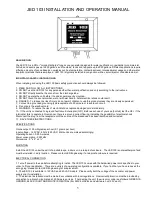
Introduction
The midiBeam wireless MIDI interface connects your MIDI instrument (or any
MIDI source) to your synthesizer or computer through radio waves, without
any cable connection. There are at least two typical applications where it has
obvious advantages:
1. If you have a battery powered mobile MIDI instrument you will be free to
move around the stage without any cable if you use midiBeam. You can use a
mobile keyboard hanging in your neck from Roland, Casio, etc., or a wind
controller, like the AKAI EWI 4000s or the Yamaha WX5.
2. If you are fed up with the many cables hanging around in your studio, you
can reduce the number of cables if you use midiBeam. Unlike other wireless
MIDI solutions midiBeam is a very cost efficient replacement for a MIDI cable,
while the delay latency is perfectly negligible, just about 10% of other
wireless solutions.
The midiBeam system consists of two boxes, midiBeam TX02 and midiBeam
RX02.
TX02 is the transmitter, powered by two AAA batteries. It is a small plastic box,
with an LED and one pushbutton on the top (“PAIRING”). The MIDI plug is
hanging out on one end on a short cable. The TX02 can be attached to the
instrument by Velcro tape.
RX02 is the receiver, it must be powered through the mini USB socket either
from a computer or from a USB power supply. It has an LED and a pushbutton
as well. The MIDI output is provided either through USB or the DIN MIDI
output socket. There is a DIN MIDI input socket too. If the radio connection is
active between the two devices then the DIN MIDI socket on the RX02 can be
used as an additional input. The two MIDI streams are merged together, and
appear at both the MIDI DIN output on the RX02, and on the computer
through USB. If the device has no radio connection (TX02 is off or not paired)
then RX02 functions as a standard MIDI Interface to a computer. No special
driver installation is necessary.
Page | 3





























